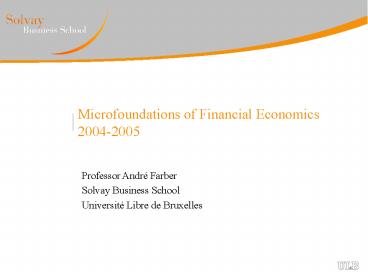Microfoundations of Financial Economics 2004-2005 - PowerPoint PPT Presentation
Title:
Microfoundations of Financial Economics 2004-2005
Description:
Microfoundations of Financial Economics 2004-2005 Professor Andr Farber Solvay Business School Universit Libre de Bruxelles – PowerPoint PPT presentation
Number of Views:103
Avg rating:3.0/5.0
Title: Microfoundations of Financial Economics 2004-2005
1
Microfoundations of Financial Economics2004-2005
- Professor André Farber
- Solvay Business School
- Université Libre de Bruxelles
2
CAPM the real stuff
- Today we will look at various classical
derivations of the CAPM. - 1. Mossin
- Equilibrium of an exchange economy
- Based on quadratic utility functions
- 2. Mathematics of the efficient frontier
3
William Forsyth Sharpe
- From Wikipedia, the free encyclopedia.
- William Forsyth Sharpe (born June 16, 1934) is
Professor of Finance, Emeritus at Stanford
University's Graduate School of Business and the
winner of the 1990 Bank of Sweden Prize in
Economic Sciences in Memory of Alfred Nobel. - Dr. Sharpe taught at the University of Washington
and the University of California at Irvine. In
1970 he joined the Stanford University. He was
one of the originators of the Capital Asset
Pricing Model, created the Sharpe ratio for
risk-adjusted investment performance analysis,
contributed to the development of the binomial
method for the valuation of options, the gradient
method for asset allocation optimization, and
returns-based style analysis for evaluating the
style and performance of investment funds. - He served as a President of the American Finance
Association. - He received his Ph.D., M.A., and B.A. in
Economics from the University of California at
Los Angeles. He is also the recipient of a Doctor
of Humane Letters, Honoris Causa from DePaul
University, a Doctor Honoris Causa from the
University of Alicante (Spain), a Doctor Honoris
Causa from the University of Vienna and the UCLA
Medal, UCLA's highest honor. - Bibliography
- Portfolio Theory and Capital Markets
(McGraw-Hill, 1970 and 2000) - Asset Allocation Tools (Scientific Press, 1987)
- Fundamentals of Investments (with Gordon J.
Alexander and Jeffrey Bailey, Prentice-Hall,
2000) - Investments (with Gordon J. Alexander and Jeffrey
Bailey, Prentice-Hall, 1999)
4
John Lintner
- Wikipedia does not yet have a page called John
Lintner. - To start the page, begin typing in the box below.
When you're done, press the "Save page" button.
Your changes should be visible immediately. - If you have created this page in the past few
minutes and it has not yet appeared, it may not
be visible due to a delay in updating the
database. Please wait and check again later
before attempting to recreate the page. - Please do not create an article to promote
yourself, a website, a product, or a business
(see WikipediaWhat Wikipedia is not). - If you are new to Wikipedia, please read the
tutorial before creating your first article, and
only use the sandbox for editing experiments. - Search for John Lintner in Wikipedia
5
Jan Mossin
- From Wikipedia, the free encyclopedia.
- Jan Mossin (b. 1936 in Oslo d. 1987) was a
Norwegian economist. He graduated with a
siviløkonom degree from the Norwegian School of
Economics and Business Administration (NHH) in
1959. After a couple of years in business, he
started his PhD studies in the Spring semester of
1962 at Carnegie Mellon University (then Carnegie
Institute of Technology). - One of the papers in his doctoral dissertation
was a very important contribution to the Capital
Asset Pricing Model (CAPM). At Carnegie Mellon he
was, among others, awarded the Alexander
Henderson Award for 1968 for this contribution.
If Jan Mossin had lived longer he would most
likely had been a candidate for the Bank of
Sweden Prize in Economic Sciences in Memory of
Alfred Nobel in 1990 together with Professors
Sharpe and Lintner. - After he had finished his PhD he returned to NHH
where he in 1968 was tenured professor.
6
CAPM à la Mossin
- 1 period model
- Investor i has quadratic utility function over
future wealth Y - n firms issue shares
- 1 share outstanding per firm
- pj price per share
- xj(s) payoff of firm j in state s
- sjk covariance of payoffs of firm j and k
7
Investors problem
8
FOC
j1,,n
Note
with zj solution of
j1,,n
9
Market clearing conditions
j1,,n
10
Equilibrium
11
Equilibrium (2)
FOC (in equilibrium) can be written as
Solving for pj
12
Equilibrium (3)
Define
bj is the contribution of company j to the
markets total variance
? is a measure of the market risk aversion, the
same for all companies
we can write the equilibrium value of the firm as
13
Beta formulation
The equilibrium price can be written as
Define
14
Mean-Variance Frontier Calculation brute force
Mean variance portfolio
s.t.
Matrix notations
15
Some math
Lagrange
FOC
Define
16
Interpretation
The frontier can be spanned by two frontier
returns
E
1
gh
A/C
Minimum variance portfolio MVP
H
0
17
Zero covariance portfolio
The covariance between any two frontier
portfolios p and q is
For any two frontier portfolios p (except the
MVP), there exists a unique frontier portfolio
with which p has zero covariance
18
Zero Covariance Portfolio in the s, E space
E(R)
p
E(Rp)
zc(p)
ERzc(p)
s(R)
19
Toward a Zero-Beta Capital Asset Pricing Model
p
E(Rp)
q
zc(p)
ERzc(p)
s(R)
20
Some math
Proof on demand see DD Chap 7
Apply to ZC portfolio
Apply to p
Divide
Rearrange
21
Another proof (more intuitive??)
Consider a fraction a invested in stock q and
(1-a) in p
The slope
is equal to the slope of tangent
As
22
Zero-Beta CAPM
In equilibrium, the market portfolio is on the
efficient frontier
If there exist a risk free asset E(Rzc(M)) Rf
Empirical test Roll critique If proxy used for
the market portfolio, linear relationship doesnt
hold
23
Next session
- Efficient frontier in Hilbert space (wooow..)
- Where are the SDF in the CAPM?















![Economics, 6th, Parkin, 2004, Chapter 9: ???? [?1?] PowerPoint PPT Presentation](https://s3.amazonaws.com/images.powershow.com/7338318.th0.jpg?_=201511040311)















